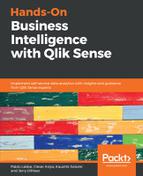Finally, we are all set up with Qlik Sense and we're ready to jump into some analysis. This section will help you understand what self-service is in Qlik Sense and why you would want to use it. Later chapters will go deeper into how to pull in your own data and create visualizations. We will be using the Sales Discovery application available on the Qlik Sense Cloud or Qlik Sense Desktop, if you would like to follow along.
Qlik Sense self-service enables users to load their own datasets, create measures and dimensions, create visualizations, and create stories without another person or group, typically IT, having to intervene. This model has become exceedingly popular over the past few years, often to the chagrin of IT professionals who are looking to protect and lock down their infrastructures; it's a difficult challenge, especially in this age of constant cyber attacks and phishing scams, to allow users access to their data freely. Fortunately for business users and IT alike, Qlik Sense makes it much easier to employ governance practices and provide users with the access they need to make data-driven decisions.
We'll start with the data model piece, and remember we'll go much further into detail in the subsequent chapters on how to create your own data model. In the following screenshot, you can see that Qlik Sense has linked these various data sources together. There is a + button in the top-left corner that allows users to add more data to the data model. At the bottom (if you select a bubble), there is a mechanism to edit the table prior to loading it and perform various types of transformations:

The data transformation interface in Qlik Sense is excellent for making basic changes to the data, such as mapping, bucketing, adjusting null values, and creating new calculated fields from data that already exists; for example, Price * Quantity to make a Sales field. Qlik Sense is also smart enough to recognize what the field types are and can make intelligent suggestions on how you may want to transform the data. In the following screenshot, you can see that Qlik Sense has identified the selected field as a numerical field, and is suggesting a bucketing function to create a meaningful dimension by which to perform some analysis. This view also provides analytics and metadata about the tables and fields you're exploring, and is a very useful tool for analyzing data integrity prior to creating visualizations:

Once the data has been loaded, it populates the application with fields, which you can then use to create Master items, including measures, dimensions, and visualizations. For many users, these Master items will already be pre-populated by the developer who created the application, which allows for easier and faster creation of visualizations, since the user doesn't have to come up with the calculations. A later chapter will detail how to create expressions and calculations of your own in Qlik Sense.
It is now very easy to begin modifying and creating dashboards with the drag-and-drop functionality that Qlik Sense provides:

Creating new sheets is a breeze: to start from an existing sheet, just right-click and duplicate, or click the Create new sheet button to start from a fresh, blank sheet:

It's even easier with the Qlik Sense Insight Advisor: to create charts, you just need to drag some measures and dimensions onto the canvas and Qlik Sense will automatically identify the field types and create meaningful visualizations for you:

Or, there's always the EASY BUTTONTM; just click on the Insights button in the top-right corner (outside of Edit mode) and click Generate insights for charts to automatically be generated. With NLP, you can type in fields that you care more about to get more specific results as well:

Self-service is extremely easy with Qlik Sense, and it's getting better with each release; however, it is important that we all make sure to create and share data ethically and safely. Self-service can easily get out of hand and open up risk for both IT and the business, so it is everyone's responsibility to remain educated on the tools and governance best practices available. Combining the right education program with appropriate governance practices, a concept known as Governance Through Education, will ensure that everyone operates in a safe and healthy environment for self-service.
